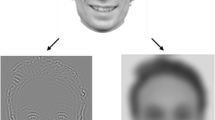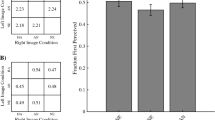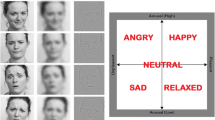Abstract
In four experiments, we investigated the presence and strength of perceptual aftereffects to emotional faces, using spatial frequency filtering to manipulate awareness of emotional content. We presented angry and happy faces as adapters and used a control condition without adaptation. Participants were subsequently requested to judge the friendliness level of a neutral target face. We confirmed the well-known aftereffect for unfiltered emotional faces in Experiment 1. In the experiment, friendliness judgments were greater for the angry than the happy or the control condition. In Experiment 2, in which the “hidden” emotional expression contained in the low spatial frequencies (LSF) was superimposed to the neutral expression presented in the rest of SF of the same image (emotional hybrid faces), the difference in friendliness judgments between angry and happy was significant, but none of the two conditions significantly differed from the control. In Experiment 3, faces were presented at LSF, confirmed a difference between the two emotions, but only the judgments of angry faces differed from the control condition. In Experiment 4, we extended the initial finding to stimuli presented at middle and high spatial frequencies (M-HSF). Finally, a comparison among all experiments revealed that the aftereffect was stronger with angry faces filtered at M-HSF than all of the other filtering conditions, whereas there were no differences for happy faces. We conclude that spatial frequency filtering influences aftereffects and that these effects are also related to emotional awareness. The results are discussed with reference to the dual route model of visual perception.


Similar content being viewed by others
References
Adams, W. J., Gray, K. L., Garner, M., & Graf, E. W. (2010). High-level face adaptation without awareness. Psychological Science, 21(2), 205–210.
Blakemore, C., & Campbell, F. W. (1969). On the existence of neurones in the human visual system selectively sensitive to the orientation and size of retinal images. Journal of Physiology, 203, 237–260.
Butler, A., Oruc, I., Fox, C. J., & Barton, J. J. (2008). Factors contributing to the adaptation aftereffects of facial expression. Brain Research, 1191, 116–126.
Chen, J., Yang, H., Wang, A., & Fang, F. (2010). Perceptual consequences of face viewpoint adaptation: Face viewpoint aftereffect, changes of differential sensitivity to face view, and their relationship. Journal of Vision, 10(3), 1–11.
Costen, N. P., Parker, D. M., & Craw, I. (1996). Effect of highpass and lowpass spatial filtering on face identification. Perception and Psychophysics, 58, 602–612.
D’Ascenzo, S., Tommasi, L., & Laeng, B. (2014). Imagining sex and adapting to it: Different aftereffects after perceiving versus imagining faces. Vision Research, 96, 45–52.
Dannlowski, U., Ohrmann, P., Bauer, J., Kugel, H., Arolt, V., Heindel, W., & Suslow, T. (2007). Amygdala reactivity predicts automatic negative evaluations for facial emotions. Psychiatry Research: Neuroimaging, 154(1), 13–20. doi:10.1016/j.pscychresns.2006.05.005.
Eastwood, J. D., Smilek, D., & Merikle, P. M. (2001). Differential attentional guidance by unattended faces expressing positive and negative emotion. Perception and Psychophysics, 63(6), 1004–1013.
Fox, C. J., & Barton, J. J. S. (2007). What is adapted in face adaptation? The neural representations of expression in the human visual system. Brain Research, 1127, 80–89.
Gao, X., & Maurer, D. (2011). A comparison of spatial frequency tuning for the recognition of facial identity and facial expressions in adults and children. Vision Research, 51, 508–519. doi:10.1016/j.visres.2011.01.011.
Gold, J., Bennett, P. J., & Sekuler, A. B. (1999). Identification of band-pass filtered letters and faces by human and ideal observers. Vision Research, 39, 3537–3560.
Goolsby, B. A., Grabowecky, M., & Suzuki, S. (2005). Adaptive modulation of color salience contingent upon global form coding and task relevance. Vision Research, 45(7), 901–930.
Graham, N. V. S. (1989). Visual pattern analyzers. New York: Oxford University Press.
Jiang, Y., & He, S. (2006). Cortical responses to invisible faces: Dissociating subsystems for facial-information processing. Current Biology, 16(20), 2023–2029.
Johnson, M. H. (2005). Subcortical face processing. Nature Reviews Neuroscience, 6, 766–774. doi:10.1038/nrn1766.
Khalid, S., Ansorge, U., & Finkbeiner, M. (2015). Supraliminal but no subliminal priming by high-spatial frequency faces in a face-sex discrimination task. Psychology, 6(12), 1486.
Kumar, D., & Srinivasan, N. (2011). Emotion perception is mediated by spatial frequency content. Emotion, 11(5), 1144. doi:10.1037/a0025453.
Laeng, B., Profeti, I., Saether, L., Adolfsdottir, S., Lundervold, A. J., Vangberg, T., … Waterloo, K. (2010). Invisible expressions evoke core impressions. Emotion, 10(4), 573–586. doi:10.1037/a0018689.
Laeng, B., Saether, L., Holmlund, T., Wang, C. E. A., Waterloo, K., Eisemann, M., & Halvorsen, M. (2013). Invisible emotional expressions influence social judgments and papillary responses of both depressed and non-depressed individuals. Frontiers in Psychology, 4, 1–7. doi:10.3389/fpsyg.2013.00291.
LeDoux, J. (1996). The emotional brain: The mysterious underpinnings of emotional life. New York: Touchstone Press.
Leknes, S., Wessberg, J., Ellingsen, D. M., Chelnokova, O., Olausson, H., & Laeng, B. (2013). Oxytocin enhances pupil dilation and sensitivity to ‘hidden’ emotional expressions. Social Cognitive and Affective Neuroscience, 8(7), 741–749. doi:10.1093/scan/nss062.
Leopold, D. A., O’Toole, A. J., Vetter, T., & Blanz, V. (2001). Prototype-referenced shape encoding revealed by high-level aftereffects. Nature Neuroscience, 4(1), 89–94.
Liddell, B. J., Brown, K. J., Kemp, A. H., Barton, M. J., Das, P., Peduto, A., & Williams, L. M. (2005). A direct brainstem–amygdala–cortical ‘alarm’ system for subliminal signals of fear. Neuroimage, 24(1), 235–243.
Livingstone, M., & Hubel, D. (1988). Segregation of form, color, movement, and depth: Anatomy, physiology, and perception. Science, 240, 740–749.
Lundqvist, D., Flykt, A., & Öhman, A. (1998). The Karolinska directed emotional faces (KDEF). Stockholm: Department of Neurosciences Karolinska Hospital.
Mather, G., Pavan, A., Campana, G., & Casco, C. (2008). The motion after effect reloadad. Trends in Cognitive Science, 12, 481–487. doi:10.1016/j.tics.2008.09.002.
Moradi, F., Koch, C., & Shimojo, S. (2005). Face adaptation depends on seeing the face. Neuron, 45(1), 169–175. doi:10.1016/j.neuron.2004.12.018.
Morris, J. S., Öhman, A., & Dolan, R. J. (1999). A subcortical pathway to the right amygdala mediating “unseen” fear. Proceedings of the National Academy of Sciences, 96(4), 1680–1685. doi:10.1073/pnas.96.4.1680.
Moutoussis, K. (2015). The physiology and psychophysics of the color-form relationship: A review. Frontiers in Psychology, 6, 1407.
Murphy, S. T., & Zajonc, R. B. (1993). Affect, cognition, and awareness: affective priming with optimal and suboptimal stimulus exposures. Journal of Personality and Social Psychology, 64(5), 723.
Nasanen, R. (1999). The spatial frequency bandwidth used in the recognition of facial images. Vision Research, 39, 3824–3833.
Oldfield, R. C. (1971). The assessment and analysis of handedness: The Edinburgh Inventory. Neuropsychologia, 9, 97–114.
Palumbo, R., Laeng, B., & Tommasi, L. (2013). Gender-specific aftereffects following adaptation to silhouettes of human bodies. Visual Cognition, 21(1), 1–12.
Pasley, B. N., Mayes, L. C., & Schultz, R. T. (2004). Subcortical discrimination of unperceived objects during binocular rivalry. Neuron, 42(1), 163–172.
Pessoa, L., & Adolphs, R. (2010). Emotion processing and the amygdala: From a ‘low road’ to ‘many roads’ of evaluating biological significance. Nature Review Neuroscience, 11(11), 773–783. doi:10.1038/nrn2920.
Pessoa, L., McKenna, M., Gutierrez, E., & Ungerleider, L. G. (2002). Neural processing of emotional faces requires attention. Proceedings of the National Academy of Sciences, 99(17), 11458–11463.
Prete, G., Capotosto, P., Zappasodi, F., Laeng, B., & Tommasi, L. (2015a). The cerebral correlates of subliminal emotions: An eleoencephalographic study with emotional hybrid faces. European Journal of Neuroscience, 42(11), 2952–2962. doi:10.1111/ejn.13078.
Prete, G., D’Ascenzo, S., Laeng, B., Fabri, M., Foschi, N., & Tommasi, L. (2015b). Conscious and unconscious processing of facial expressions: Evidence from two split-brain patients. Journal of Neuropsychology, 9, 45–63. doi:10.1111/jnp.12034.
Prete, G., Laeng, B., Fabri, M., Foschi, N., & Tommasi, L. (2015c). Right hemisphere or valence hypothesis, or both? The processing of hybrid faces in the intact and callosotomized brain. Neuropsychologia, 68, 94–106. doi:10.1016/j.neuropsychologia.2015.01.002.
Prete, G., Laeng, B., & Tommasi, T. (2014). Lateralized hybrid faces: Evidence of a valence-specific bias in the processing of implicit emotions. Laterality, 19(4), 439–454. doi:10.1080/1357650X.2013.862255.
Rhodes, G., Jeffery, L., Watson, T. L., Jaquet, E., Winkler, C., & Clifford, C. W. G. (2004). Orientation-contingent face aftereffects and implications for face-coding mechanisms. Current Biology, 14, 2119–2123.
Rotshtein, P., Vuilleumier, P., Winston, J., Driver, J., & Dolan, R. (2007). Distinct and convergent visual processing of high and low spatial frequency information in faces. Cerebral Cortex, 17(11), 2713–2724.
Schiller, P. H., & Malpeli, J. G. (1977). Properties and tectal projections of monkey retinal ganglion cells. Journal of Neurophysiology, 40, 428–445.
Schyns, P. G., & Oliva, A. (1994). From blobs to boundary edges: Evidence for time-and spatial-scale-dependent scene recognition. Psychological Science, 5(4), 195–200.
Skinner, A. L., & Benton, C. P. (2010). Anti-expression aftereffects reveal prototype-referenced coding of facial expressions. Psychological Science, 21(9), 1248–1253. doi:10.1177/0956797610380702.
Sperandio, I., Lak, A., & Goodale, M. A. (2012). Afterimage size is modulated by size-contrast illusions. Journal of Vision, 12(2), 18.
Suslow, T., Kugel, H., Ohrmann, P., Stuhrmann, A., Grotegerd, D., Redlich, R., & Dannlowski, U. (2013). Neural correlates of affective priming effects based on masked facial emotion: An fMRI study. Psychiatry Research: Neuroimaging, 211(3), 239–245. doi:10.1016/j.pscychresns.2012.09.008.
Tamietto, M., & De Gelder, B. (2010). Neural bases of the non-conscious perception of emotional signals. Nature Review Neuroscience, 11(10), 697–709. doi:10.1038/nrn2889.
Taylor, S. E. (1991). Asymmetrical effects of positive and negative events: The mobilization-minimization hypothesis. Psychological Bulletin, 110(1), 67.
Varga, E. T., Elif, K., Antal, A., Zimmer, M., Harza, I., Paulus, W., & Gyula, K. (2007). Cathodal transcranial direct current stimulation over the parietal cortex modifies facial gender adaptation. Ideggyogy Sz, 60(11–12), 474–479.
Vuilleumier, P., Armony, J. L., Driver, J., & Dolan, R. J. (2003). Distinct spatial frequency sensitivities for processing faces and emotional expressions. Nature Neuroscience, 6, 624–631. doi:10.1038/nn1057.
Wang, S., Eccleston, C., & Keogh, E. (2015). The role of spatial frequency information in the recognition of facial expressions of pain. Pain, 156(9), 1670–1682. doi:10.1097/j.pain.0000000000000226.
Williams, M. A., Morris, A. P., McGlone, F., Abbott, D. F., & Mattingley, J. B. (2004). Amygdala responses to fearful and happy facial expressions under conditions of binocular suppression. The Journal of Neuroscience, 24(12), 2898–2904.
Wincenciak, J., Dzhelyova, M., Perrett, D. I., & Barraclough, N. E. (2013). Adaptation to facial trustworthiness is different in female and male observers. Vision Research, 87, 30–34.
Yamashita, J. A., Hardy, J. L., De Valois, K. K., & Webster, M. A. (2005). Stimulus selectivity of figural aftereffects for faces. Journal of Experimental Psychology: Human Perception and Performance, 31(3), 420.
Yang, E., Hong, S. W., & Blake, R. (2010). Adaptation aftereffects to facial expressions suppressed from visual awareness. Journal of Vision, 10(12), 24.
Yip, A. W., & Sinha, P. (2002). Contribution of color to face recognition. Perception, 31, 995–1003.
Zaidi, Q., Ennis, R., Cao, D., & Lee, B. (2012). Neural locus of color afterimages. Current Biology, 22, 220–224. doi:10.1016/j.cub.2011.12.021.
Acknowledgements
We thank Imma Servillo and Gianluca Durante, who helped us in recruiting and testing participants.
Author information
Authors and Affiliations
Corresponding author
Ethics declarations
Conflict of interest
Giulia Prete, Bruno Laeng, and Luca Tommasi declare that they have no conflict of interest.
Ethical approval
All procedures performed in the four studies described were in accordance with the ethical standards of the institutional research committee and with the 1964 Helsinki declaration and its later amendments.
Informed consent
Since the present study did not involve patients, children or animals, as well as drugs, genetic samples or invasive techniques, verbal informed consent was obtained from all individual participants included in the study.
Rights and permissions
About this article
Cite this article
Prete, G., Laeng, B. & Tommasi, L. Modulating adaptation to emotional faces by spatial frequency filtering. Psychological Research 82, 310–323 (2018). https://doi.org/10.1007/s00426-016-0830-x
Received:
Accepted:
Published:
Issue Date:
DOI: https://doi.org/10.1007/s00426-016-0830-x




